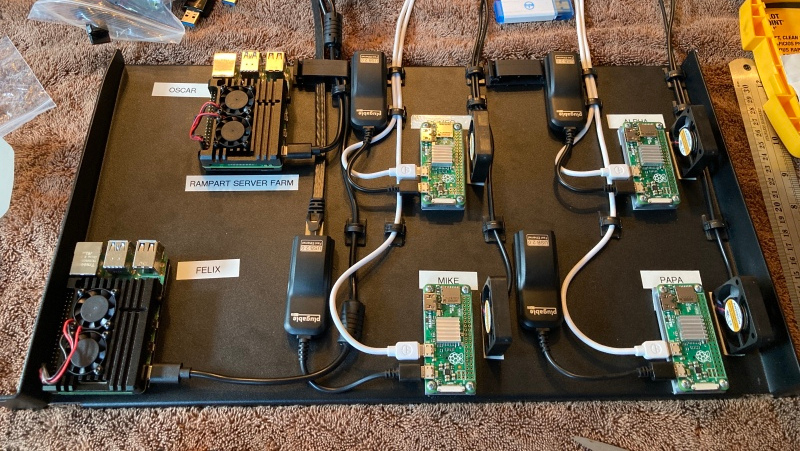[P B Richards] and [Aaron Flin] were bemoaning the resource hunger of modern JavaScript environments and planned to produce a system that was much stingier with memory and CPU, that would fit better on lower-end platforms. Think Nginx, NodeJS, and your flavour of database and how much resource that all needs to run properly. Now try wedge that lot onto a Raspberry Pi Zero. Well, they did, creating Rampart: a JavaScript-based complete stack development environment.
The usual web applications have lots of tricks to optimise for speed, but according to the developers, Rampart is still pretty fast. Its reason for existence is purely about resource usage, and looking at a screen grab, the Rampart HTTP server weighs in at less than 10 MB of RAM. It appears to support a decent slew of technologies, such as HTTPS, WebSockets, SQL search, REDIS, as well as various utility and OS functions, so shouldn’t be so lightweight as to make developing non-trivial applications too much work. One interesting point they make is that in making Rampart so frugal when deployed onto modern server farms it could be rather efficient. Anyway, it may be worth a look if you have a reasonable application to wedge onto a small platform.
We’ve seen many JavaScript runtimes over the years, like this recent effort, but there’s always room for one more.
















Ten *MEGA*bytes?
My first Linux box was a 386 (admittedly a DX40, thanks, AMD) with *four megabytes*. It ran X with a choice of window managers (TWM, of course, olwm, and my favourite GWM, by Nicolas Nahaboo!). Emacs, LaTeX and what not.
Kids, these days. Sheesh.
Heh, that’s still 32-bit! And 40MHz? Luxury!
My first start was with one of these: https://en.wikipedia.org/wiki/Toshiba_T3100
80286 running at 8MHz, and even that was an upgrade because the machine apparently had an 80287 math coprocessor. And 640KB worked just fine thank-you!
That’s nothing, you two! I use stones that I place in a checkerboard layout drawn into sand to do calculations.
https://xkcd.com/505/
You had rocks??
That’s not fair! You’ve got rocks! All I have is these machine guns!
(In thick Yorkshire accent) You had stones and sand, bloody luxury. When I were a lad are dad used t’ line me and me brothers up and beat us in binary, least till are John had accident down t’pit. Then there were only 7 of us, had to wait till our ma had another, and like it we did.
https://www.youtube.com/watch?v=26ZDB9h7BLY
(For anyone who’s wondering what’s going on)
You went down’t pit for stones? Loooksureh!
When I were lad, we used to pay pit owner to tak us on, then he threw us down’t pit shaft, and we had to crawl out wi’ broken arms and legs wi stones in us mouths. And you tell t’kids of today, they don’t know they’re born….
You had 7 other brothers to receive stuff in parallel? Luxury! I was on my own so had to receive the data serially!
PDP-11/40 for me, 56K core memory, two 2.4MB RK05 drives, no MMU or multiply instruction, running Mini-UNIX. It belonged to the university’s EE department.
Mini-UNIX ran on MMUless PDP-11s by devoting the first 24K bytes to the kernel and the remaining 32K to a single userspace program. A context switch wrote the whole 32K of user memory to the swap volume and read back a different process’s memory. It took about three seconds.
If we’re counting computers owned by others, my first was an Amdahl 470/V8 w/16MB of memory and (if I remember correctly) 1GB of disk space spread out over a large room full of “dishwashers.”
My first personal computer was a PC/XT. I souped that bad boy up with a NEC V20!
You most assuredly did not run Linux on a 286 though.
My first Linux machine was also a 386, it was basically the thing in those days. But before that (14 years before that, in fact), started on a Z80. I still have the 8 inch floppy that contains the first code I wrote for money, back in ’82. It involved patching a few bytes in the boot sector with a binary editor, built into the ROM of an Apple II. Linux? Luxury!
Ah the Apple II – I had a 2+ and by the time I was done with it I had cooked every GPIO on the “game port” from hooking up my own custom contraptions including a CDS cell and the output from a quartz clock second hand solenoid so I could get a PPS signal (no clock, let alone a RTC) to time my darkroom enlarger exposures… It did NOT run a web server and you definitely had to be sure to seed the random number generator. Ah the good old days in the basement. It was solving real problems though.
Linux wouldn’t run on a 286. But IBM offered System III Unix on the PC/XT. It was one of the four launch operating systems for that computer model, the others being PC-DOS, CP/M, and a fourth whose name I’ve forgotten.
ELKS linux would most assuredly run on a 286 machine …
He he, squish that cat
Lets focus on Rampart people
(In a bad ‘Mericun Yorkshire accent) It’s all good, we sharpened our rocks. At my old company we first ran Linux on a HP 386 booted from floppys, and the company ran Intel/AT&T SysV R4 on a 286 at one point. Embarrassingly, I wrote some of the regular expression matchers that are buried deep in Rampart on a 286. (Anybody remember KA9Q’s drivers?)